Home Page / Entertainment Home / More Preferences / Gallery
Introducing 'The Navy Lark'
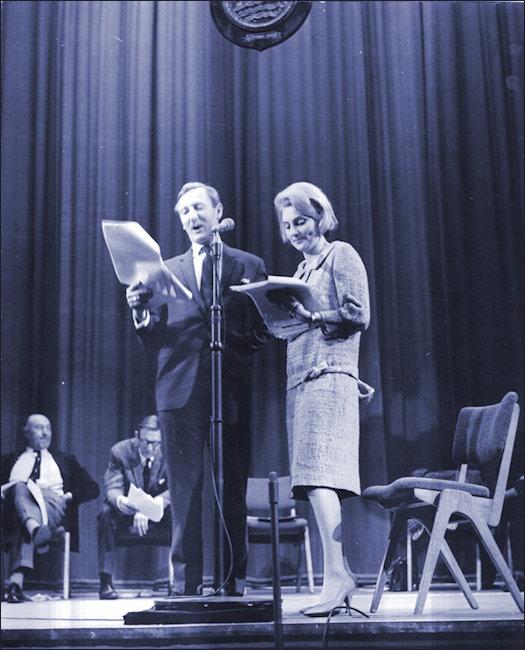
Leslie Phillips and Heather Chasen performing to a live audience and broadcast - see the Troutbridge Shield above their heads! Image courtesy of Noelle Wyman-Blundel
Special Write-Up by Fred Vintner for this page
For 15 series over 17 years Tommy Reilly's evocative rendition of the Trade Wind Hornpipe heralded 30 minutes of naval mayhem in and around Portsmouth with occasional forays onto the high seas aboard the fictional frigate HMS Troutbridge. 'The Navy Lark' was first broadcast on the BBC Light Programme. Created by Lawrie Wyman (writer) and Alastair Scott Johnston (producer) listeners entered a world of comradeship, wheeling and dealing, innocence, and incompetence. The humour drew on relationships. The characters muddled through life in a relatively carefree way. HMS Troutbridge was crewed by incompetent men barely tolerated by the assertive womenfolk they encountered at work and at home. Eccentric personalities were woven into storylines to provide comic potential. The regular cast of 9 would voice up to 22 different parts for a single show which ultimately totalled 560 characters in the show’s run. On rare occasions known actors such as Frank Thornton, Chic Murray and June Whitfield and around a dozen more performed cameo roles in storylines when extra voices were required after Ronnie Barker left ( Series 11). Jon Pertwee is on record as telling the BBC that he ought to be the new voices man but his role within the show remained as it previously was but George Evans is now recognised as a co-scriptwriter along with Lawrie Wyman.
Alastair Scott Johnston secured the go ahead for The Navy Lark in around 8 weeks from BBC management in early 1959. Original proposals for a new `services` inspired show included 'The Air Force Lark' and `The Army Lark`. However, as Alastair had served in the Army (tanks), Lawrie Wyman, the script writer, had a brief spell in the Air Force they choose the Navy because it was reasoned that `Jolly Jack Tar` could be forgiven every indiscretion or minor shortcoming because he would have spent long periods at sea.
The original cast in the original proposal put to the BBC management included Michael Denison, Leslie Phillips, Jon Pertwee and Thora Hird. The framework was intended to be ideal for introducing other big names into the story from time to time. An inspection of the detachment by Jack Hawkins in his best 'stiff upper lip, quiet trip Number One, how about a mug of cocoa?' manner, for an example.
By the time the show went to air Dennis Price, Leslie Phillips and Jon Pertwee were variously described as 'stars' by the BBC announcer in the programme's introduction and end credits. This was a pre-requisite of the show; so avoiding the idea that it was a single person’s show with a supporting cast. The Navy Lark was an ensemble production with a very strong team ethos. The name order rotated each week to illustrate the programme’s ‘ensemble’ approach to broadcasting as an antidote to a ‘star’’ with a cast.
In the first season the immensely suave Dennis Price was given the part of `Number 1`, Troutbridge's senior officer. His eloquent voice alongside his forbearing but authoritative approach for command were never more taxed than by CPO Pertwee, who believed HM stores were there for his benefit rather than the Navy’s. The potential for an ongoing tension and battle of wits between decks was delightfully engaging. Unfortunately, the lure of Hollywood and a lucrative film career meant that Dennis Price was enticed to America after the first season. Stephen Murray subsequently joined the cast as `Number 1` in October 1959 and was to remain resident aboard Troutbridge for the next 17 years.
Leslie Phillips' contribution to 'The Navy Lark' was profound. Sub Lt. Phillips displayed a sense of innocence, naivety and lustful incompetence together with his navigational mayhem. He personified ineffectiveness. He was vain, guileless and totally oblivious to what others thought of him. His maritime exploits gave us various memorable phrases none more so than "left hand down a bit" and those ever so lecherous laughs.
Jon Pertwee’s ability to mimic and entertain as whilst employing his unique vocal dexterity frequently drew upon real characters he had encountered and so provided a wealth of comic personalities which were woven into the fictional plots! Jon's brilliantly diverse vocal caricatures were so well executed, that any listener might be forgiven for believing that different actors were responsible for each voice. It is interesting to note that in real life Jon's cousin's was a crew member of HMS Troutbridge which became the fictional HMS Troutbridge.
Richard Caldicot played the continually harassed Commander (and eventually Captain) Povey with aplomb. A stickler for rules and naval protocol he was ever thwarted by events. Heather Chasen was THE female actor of the show. Already an established radio and stage performer, it fell on Heather to voice every female character in the show for many a year until Judy Cornwell joined the cast and relieved Heather of having to talk to herself in different voices on occasions. On one occasion Heather is heard to leave the room as a door slams and reappears as another character which made Leslie Phillips quip off script. Tenniel Evans never missed a broadcast. As the old soak Todhunter-Brown would stumble through speeches without any appreciation of lucidity. Tenniel’s best known character was that of the ambivalent Able Seaman (later Leading Seaman) Goldstein, constantly radioing messages to the bridge and reminiscing about Wales. Michael Bates delivered a wide range of characters but his memorable creations include the (chanting) ship's padre and the persistently sneezing Captain Acheson. A struggling young actor Ronald Barker successfully transferred from the theatre to a `minor` Navy Lark role but had worked with Alastair Scott Johnston previously on The Floggit’s. Listeners were hugely impressed and entertained by Ronnie (subtle name change from his theatre billing – Ronald ) Barker's amazing ability to create distinctive voices and personalities his potential was instantly recognised and rapidly developed within the show and was given more lines with the blessing of the cast’s major actors. Everyone who listened was entertained by Lt. Cdr. Stanton’s incompetence as a senior officer with a passion for fishing. But, for many his best comic inventions were those of Troutbridge’s hopeless Chief Engineer Lt. Queeg desperate for support and the sardonic MOD official who would telephone Troutbridge and say in a very lewd and inappropriate voice " Intelligence speaking".
Such was the runaway success of the Navy Lark radio show a film version was immediately commissioned as soon as series 1 came off air. Regrettably, the only cast member to transfer from radio to the movie was Leslie Phillips as the film’s producers believed Ronald Shiner, Cecil Parker and Cardew Robinson were more `bankable`. Hattie Jacques and Elvi Hale generated the female interest. The Navy Lark was the last radio series to transfer to the silver screen.
ITV (Rediffusion) made a television version of the show featuring Richard Caldicot and Frank Thornton which ran for 26 shows in 1964. The entire series which was filmed at sea with fantastic Royal Navy support together with studio work at Pinewood appears to have been “junked” but rumours abound of the existence of one show surviving the chop.
The whole radio cast were called back to Troutbridge on July 16 1977 for the Queen's Silver Jubilee, and a final Troutbridge reunion with a reduced cast was broadcast on Boxing Day in 1992.
The Navy Lark has left us with over 120 hours of radio fun continues to deliver as much joy now as when it first navigated the air waves 53 years ago. Two Christmas episodes were recorded especially for the Antarctic scientific survey team in 1962 and 1965 (never broadcast in the UK but are available through the club) demonstrate how much every service listener meant to this show’s company no matter where they were.'

"Hello Anna,
Just a quick enquiry, did my mail out to you arrive? If not, I have found a simpler resume that might be useful.
All the best - Grand Day - Fred Vintner"
The Radio Times announcing the launch of a 'new series' on 9th October 1959
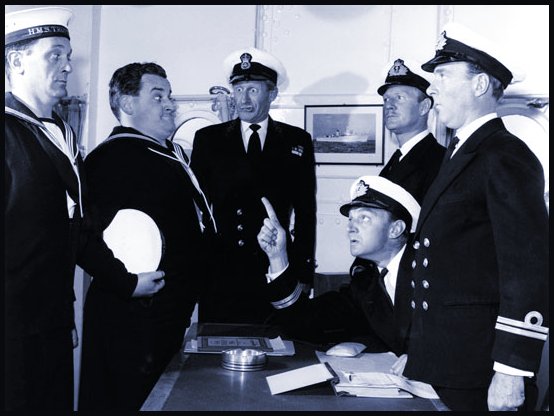
The cast of radio comedy series 'The Navy Lark' (from left to right): Tenniel Evans, Ronnie Barker, Jon Pertwee, Leslie Phillips, Stephen Murray (seated) and Michael Bates. Image © BBC British Broadcasting Corporation
16th July 1977 - The Navy Lark Silver Jubilee Special
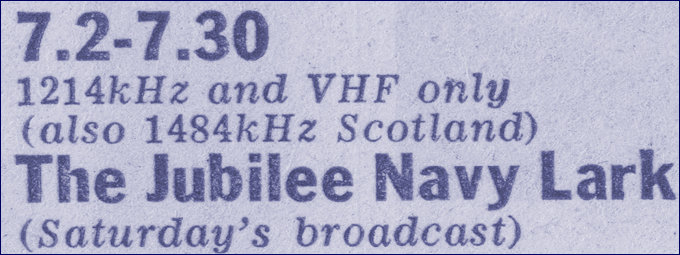
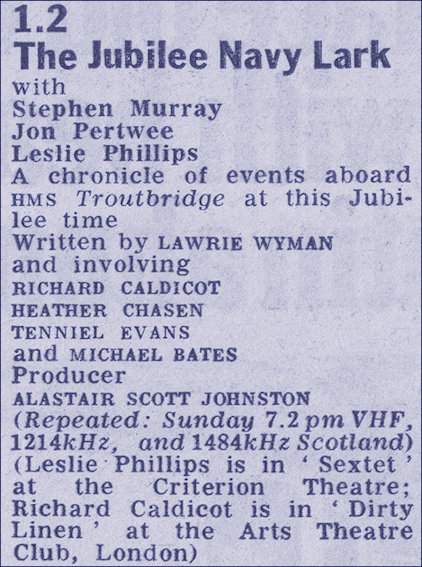
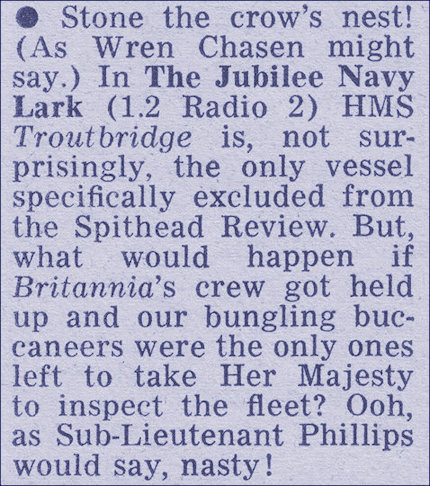
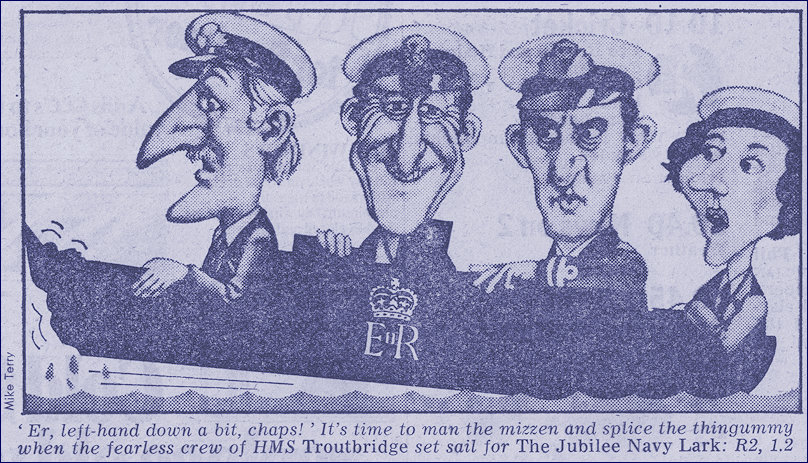
Images sourced from Richard Cummings and The Navy Lark Fan page on Fb
Still going strong in 2017
BBC Radio 4 Extra publicity page for regular broadcasts of 'The Navy Lark' and the not-so-well received 'Tv Lark'
From the British Comedy Radio web-site
The Navy Lark was a BBC radio comedy written by Laurie Wyman and George Evans about the crew of The Royal Navy ship HMS Troutbridge and their mis-adventures. The show was first aired on The Light Programme in 1959 and ran for thirteen series until 1976 making it the second longest running radio programme the BBC has made.
The main characters of The Navy Lark are: Chief Petty Officer Pertwee, played by Jon Pertwee; Sub Lieutenant Phillips, played by Leslie Phillips and The Number One, which was played by Dennis Price in the first series and Stephen Murray from then on. The rest of the regular characters (too many to list here – see the cast and crew section) were played by Richard Caldicot, Ronnie Barker, Tenniel Evans, Michael Bates and Heather Chasen.
The series used accents and characterised voices to supplement the humour, as well as a good deal of innuendo. The programme featured musical breaks with a main harmonica theme by Tommy Reilly and several enduring catchphrases, most notably from Sub Lieutenant Phillips: “Corrrrr”, “Ooh, nasty…”, “Oh lumme!”, and “Left hand down a bit”.
“Ev’rybody down!” was a phrase of CPO Pertwee’s, necessitated by a string of incomprehensible navigation orders by Phillips, and followed by a sound effect of the ship crashing. Also, whenever Pertwee had some menial job to be done, Able Seaman Johnson was always first in line to do it, inevitably against his will: “You’re rotten, you are!”. The telephone response from Naval Intelligence (Ronnie Barker), was always an extremely gormless and dimwitted delivery of “‘Ello, Intelligence ‘ere” or ‘This is intelligence speakin'”. Other recurring verbal features were the invented words “humgrummits” and “floggle-toggle” which served to cover all manner of unspecified objects ranging from foodstuffs to naval equipment.
The series made household names of Leslie Phillips, Jon Pertwee and Richard Caldicot, but Ronnie Barker’s versatile contributions were only recognised after he had become better known through television comedy. Michael Bates later appeared on television as Blamire in Last of the Summer Wine and as Rangi Ram in It Ain’t Half Hot Mum. Judy Cornwell was later to appear in the short series Moody and Pegg, but became best known when she was cast as Daisy, one of Hyacinth Bucket’s sisters in Keeping Up Appearances. Dennis Price returned for a guest appearance in the fourth series episode A Hole Lieutenant. There were several radio sequels, including The Embassy Lark and The Big Business Lark. The TV Lark was intended to be a replacement for The Navy Lark starting with what would have been the series’ fifth season. This situation came about due to the head of light entertainment believing that “forces” based humour had had its day and television was the next “big thing” so Lawrie was told to create a show with the same cast in an independent TV station situation. Alastair Scott Johnston and Lawrie Wyman tried to stop this folly but were over ruled, hence the arrival of The TV Lark. The entire cast had been drummed out of the service (as the announcer puts it) and hired by Troutbridge TV Ltd. Janet Brown joined the cast due to the absence of Heather Chasen for this season. However, mainly due to public pressure, the production team of Alastair Scott Johnston and Lawrie Wyman managed to revert the show back to nautical capers, and episode ten of The TV Lark revealed that although CPO Pertwee had arranged to flog almost the entirety of HMS Troutbridge. Storylines in The TV Lark nudged back to Naval origins across the ten shows until they were finally reunited with Troutbridge and acceptable storylines once more. 10 episodes were made but unfortunately Episode 9 is lost. The nine surviving episodes are available on YouTube.
In 1959 a film version was made, written by Laurie Wyman and Sid Colin and directed by Gordon Parry. It starred Cecil Parker, Ronald Shiner, Elvi Hale, Leslie Phillips and Nicholas Phipps.
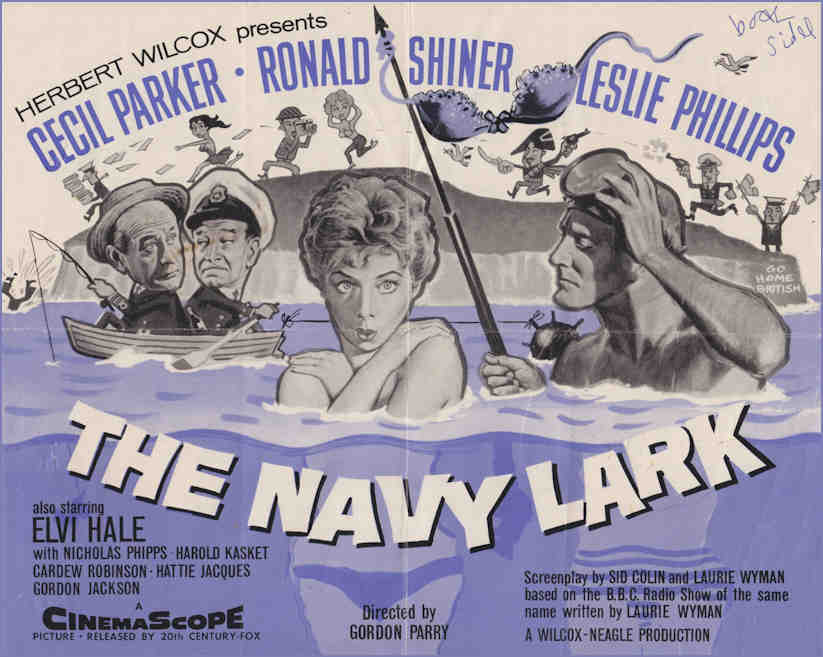
Wyman co-wrote with three other writers a television sitcom HMS Paradise (Associated-Rediffusion, 1964-5) set in a naval shore establishment in which Caldicot played Captain Turvey, but only one series was made. The entire series has been wiped, but a rumour exists that one episode still exists. The show was condensed from 30 to 27 minutes by Transcription services, the discs were then exported around the world except for South Africa. As Springbok Radio was a commercial station the BBC refused to allow the station to re-broadcast the British shows so the station acquired the scripts from Lawrie and edited them to around twenty five minutes, to accommodate the commercial breaks,the revised show was recorded them in front of a live audience before broadcasting them. All the UK associations were kept for the Durban audiences which must have been incomprehensible on occasions. Excerpts of these broadcasts can be heard on the Springbok celebration site and occasionally Pumamouse. IMDB
From the BBC web-site
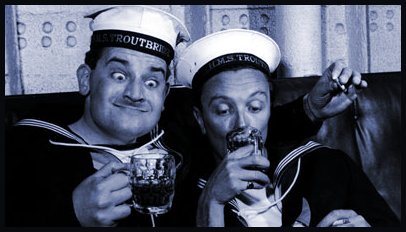
One of those radio shows that went on forever, The Navy Lark ran for 18 years and 244 episodes, and made Jon Pertwee and Leslie Phillips famous.
HMS Troutbridge is stationed off Portsmouth, where its inhabitants are always getting themselves out of trouble - trouble that they have usually caused. In a similar way to The Goons, The Navy Lark traded on its menagerie of weird characters, odd voices and silly catchphrases. Characters were almost entirely mad: sneezing Captain Ignatius Aloysius A-A-A-Atchinson, Commander Weatherby who never spoke a clear sentence, and Sir Willoughby Todhunter Brown. The comparison with The Goons, though, only goes so far, because writer Laurie Wyman, though expert - you try writing 240-odd episodes of anything and be funny - was no Spike Milligan. More reliable, perhaps, and more consistent, but the Navy Lark simply doesn't stand up against its more famous confrere.
Both were children of their times, but The Goons transcended theirs. The Navy Lark relied far too heavily on accents, and speech impediments. The sexism was rife - fair enough in the 1950s, but it's uncomfortable now to hear the women involved treated almost literally as card-carrying morons. However, it's still funny, principally for the energy from Pertwee, Phillips and Ronnie Barker. Phillips perfected his 'dear lady' persona here, and Pertwee and Barker tore the scripts to pieces with their voices and caricatures. The performing was everything, and they poured enough power into their playing to make the series - mostly - still very listenable and funny, if prompting a lot of groans along the way. The Navy Lark was an early spin off machine, with The Embassy Lark, The Big Business Lark and The TV Lark as well as a Navy Lark movie being made in 1959.
But its roots were on HMS Troutbridge, and that's where all the best Larks were had.
Cast*
Ronnie Barker ........................ A.B. Johnson (Able Seaman "Fatso" Johnson), Lt Commander Stanton
Stephen Murray ..................... Lieut. Murray
Richard Caldicot ................... Commander Povey
Leslie Phillips ......................... Sub. Lieut Phillips
Michael Bates ....................... Captain Ignatius Aloysius A-A-A-Atchison, Lieutenant Bates
Jon Pertwee ........................... Chief Petty Officer Pertwee, Commander Weatherby
Tenniel Evans......................... Taffy Goldstein, Sir Willoughby Todhunter Brown
Crew
Laurie Wyman - writer
George Evans - writer
Sir Alastair Scott-Johnston - producer
* Not forgetting Dennis Price who made the first two series so memorable as No. 1.
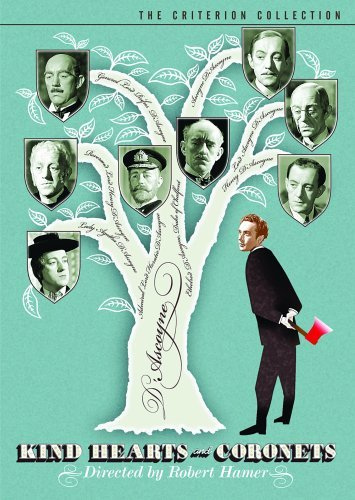
Dennis Price, the original 'Number One', studio shot - it is very difficult to source an image of DP in naval uniform - Dennis will always be associated with 'Kind Hearts and Coronets' one of the quintessential British Classics also starring Alec Guinness in eight roles!
Episode Guide: (Under Construction)
Series 1
Series 2 -
Gunboat to Goomba Ep 7/ The Radar Talk-Down System Ep 14
Broadcast 27th November 1959 and 15th January 1960 respectively
Series 3
Series 4
Series 5
Series 6
Series 7
Series 8
Series 9
Series 10
Series 11
Series 12 -
The Put-a-horse-out-to-graze Fund / Impressions for Survival / The Beard-Growing Race / The Mysterious Radio Signals / Operation Recovery / The Slogan Contest / Sir Willoughby at Shanghai / Operation Cowes Barge / Number One's Anniversary / The Loch Ness Monster
Broadcast between 16th May and 18th July 1971
Series 13
Series 14
The Montezula Revolution / The Island Swordfish / Bunged in the Rattle / Kangaroo Polka / The Digital Isles go Unstable / Egbert Hitches a Ride / Povey - and Admiral at last / The Bergholm Horse Trials / Captain Povey's Wig / THe Brain Pill / Operation Showcase / CPO Pertwee - Yachtmonger / The Talpinium Shell / John Pertwee's Sketchbook
Series 15
Page updated : 4th April 2018